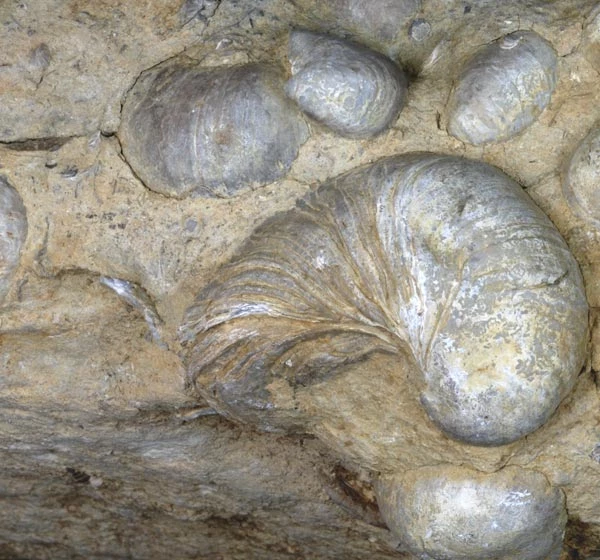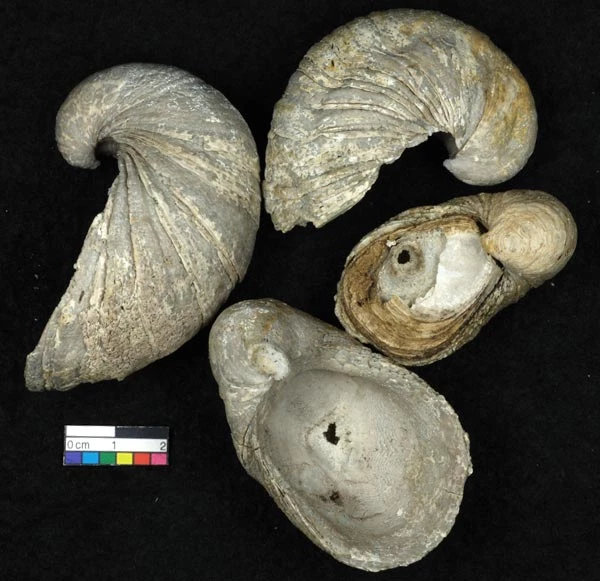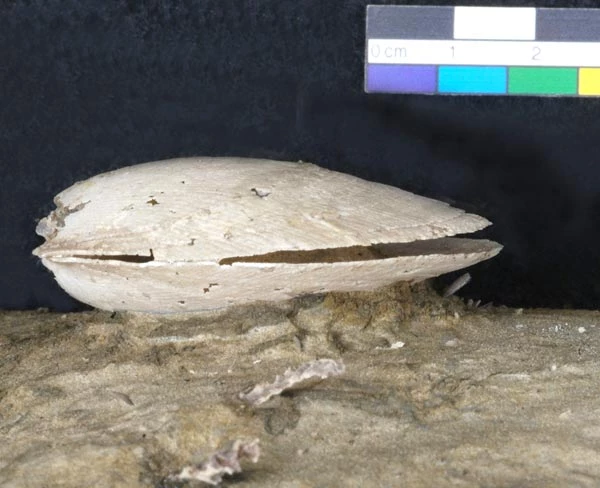Fossils in stone: acid preparation of fossils
A limestone rock, from Southerndown in south Wales, containing fossil shells. (Gryphaea arcuata — Devil's toenails).
Fossil shells (Gryphaea arcuata – Devil's toenails) after the rock has been dissolved in acid.
A fossil bivalve shell that has been partially prepared using acid. The two parts of the shell (the valves) are still attached to each other, and the bottom valve is still attached to the rock.
We rarely find fossils in perfect condition. When we collect them, most of them are partially or almost completely concealed in rock. To study them in detail, or to prepare them to be displayed, we must carefully remove the rock.
It's not easy to remove the rock from the fossils, which are sometimes extremely delicate. It can be a long and painstaking process. Sometimes we use hand tools, like pins, scrapers or little chisels. We can also use specialist tools, like pneumatic pens similar to engraving devices. A third option is to use an air-abrasive machine that is little like a miniature sandblaster.
An alternative is to dissolve the rock in acid. Most fossil shells were composed originally of calcium carbonate, and many are preserved in
limestone , which is the same chemical make-up. In some circumstances, however, the calcium carbonate of the shells dissolves away and is replaced by silica, but the enclosing limestone remains unchanged. Because limestone dissolves readily in acid, but silica doesn't, we can extract these specimens with chemicals.Vinegar, no salt please
The acid we commonly use is acetic acid — the same acid that is in vinegar. We use highly concentrated acetic acid, 80%, but dilute it with water to about 5%.
We immerse the rock sample containing fossils in the diluted acetic acid, which almost immediately starts to fizz as it reacts with the limestone.
The rock can take anything from a few days to many months to dissolve completely, depending on its specific composition. The reaction with the rock gradually neutralizes the acid, which needs to be refreshed from time to time. At the end of the process all that remains is some slushy rock residue, and the silicified fossils.
Many silicified fossils are very delicate; they have to be handled with extreme care, and we often need to strengthen them with adhesives.
The fossils are now ready for research or for displaying. Many are exquisitely preserved: 450-million-year-old silicified shells sometimes look as if they have just been picked up from a modern beach!



Comments - (11)
My wife and I just purchased a property in North Texas, about 30 miles west of Fort Worth. We have what looks like the "Devil's toenails" by the hundreds preserved in larger pieces of limestone as well as individual specimens scattered across the surface of our yard. The previous owners had a new septic system installed a couple of years ago so I suspect these were dug up during that process. My daughters and I have been collecting them and setting them aside for further investigation but by the looks of some of the previous comments, they are fairly common in this area. Would love to get more info if possible. Thank you.
Barry
It's amazing to find fossils like this anywhere. I'm afraid that we can't identify or comment about any without good photographs though. If these are from Texas it might be worth you contacting your nearest museum with a geological curator.
Dear Jenny Kenward,
Thank you for getting in touch with us. I have passed your enquiry to my colleagues within the natural sciences department. They will be able to advise further on this.
Many thanks,
Nia
(Digital team)
Hi Cindy,
As a general rule the acid should be refreshed when it stops fizzing. it is all dependent on the type of acid being used and the rock type that you are dissolving.
Kind Regards,
Amanda
(Senior Laboratory Officer (Natural Sciences) - National Museum Wales)